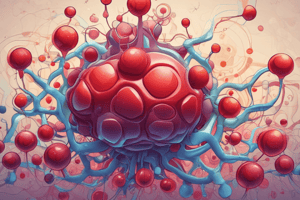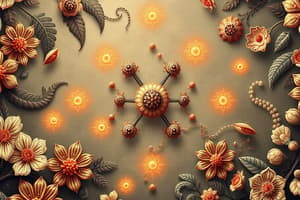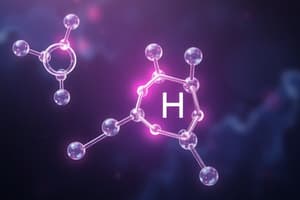Podcast
Questions and Answers
Which functional group is part of carbohydrates and contributes to their hydrophilicity?
Which functional group is part of carbohydrates and contributes to their hydrophilicity?
- Carbonyl
- Hydroxyl (correct)
- Amino
- Ester
Sulfhydryl groups are non-polar and do not contribute to hydrophilicity.
Sulfhydryl groups are non-polar and do not contribute to hydrophilicity.
False (B)
What charge do carboxyl groups typically carry at body pH?
What charge do carboxyl groups typically carry at body pH?
negatively charged
The ______ group is part of ATP and nucleic acids and is negatively charged.
The ______ group is part of ATP and nucleic acids and is negatively charged.
Match the following functional groups with their significance:
Match the following functional groups with their significance:
Which of the following functional groups is found in amino acids and commonly carries a positive charge at body pH?
Which of the following functional groups is found in amino acids and commonly carries a positive charge at body pH?
Carboxyl groups are negatively charged and contribute to the hydrophilicity of compounds at body pH.
Carboxyl groups are negatively charged and contribute to the hydrophilicity of compounds at body pH.
What is the significance of the phosphate group in biological molecules?
What is the significance of the phosphate group in biological molecules?
The ______ group is part of dietary fats and oils and contributes to the structure of triglycerides.
The ______ group is part of dietary fats and oils and contributes to the structure of triglycerides.
Match the following functional groups with their main characteristics:
Match the following functional groups with their main characteristics:
Flashcards are hidden until you start studying
Study Notes
Functional Groups of Organic Compounds
-
Hydroxyl (R-O-H)
- Characterizes alcohols
- Provides a polar group, contributing to hydrophilicity in various compounds
-
Sulfhydryl (R-S-H)
- Integral to thiols, including amino acids like cysteine and methionine
- Exhibits polarity and contributes to hydrophilicity
-
Carbonyl
- Part of ketones (structure on the left) and aldehydes (structure on the right)
- Exhibits polar characteristics and is hydrophilic
-
Carboxyl
- Found in carboxylic acids and amino acids
- At physiological pH, carboxyl groups carry a negative charge, enhancing hydrophilicity
-
Ester
- Common in dietary fats, oils, and triglycerides
- Some medications, including aspirin, are classified as esters
-
Phosphate
- Essential part of ATP and nucleic acids
- Negatively charged and exhibits strong hydrophilicity
-
Amino
- Key component of amino acids
- At body pH, most amino groups are positively charged, contributing to hydrophilicity
Functional Groups in Organic Compounds
-
Hydroxyl (R-O-H):
- Found in alcohols; consists of an oxygen and hydrogen atom.
- Provides hydrophilicity due to its polar nature.
-
Sulfhydryl (R-S-H):
- Present in thiols, such as the amino acids cysteine and methionine.
- Exhibits polarity, contributing to hydrophilicity in specific compounds.
-
Carbonyl:
- Integral to ketones and aldehydes; contains a carbon double-bonded to oxygen.
- Exhibits polar characteristics, enhancing hydrophilicity.
-
Carboxyl:
- Component of carboxylic acids and amino acids; features both a carbonyl and a hydroxyl group.
- At physiological pH, carboxyl groups carry a negative charge and possess hydrophilic properties.
-
Ester:
- Found in dietary fats, oils, and triglycerides; characterized by an -O- bond connecting a carbon chain to a carbonyl.
- Some medications, such as aspirin, are classified as esters.
-
Phosphate:
- Essential to ATP and nucleic acids; comprises a phosphorus atom bonded to four oxygen atoms.
- Carries a negative charge, making it very hydrophilic.
-
Amino:
- Integral to amino acids; characterized by a nitrogen atom bonded to hydrogen atoms.
- At physiological pH, most amino groups exhibit a positive charge, contributing to hydrophilicity.
Studying That Suits You
Use AI to generate personalized quizzes and flashcards to suit your learning preferences.




